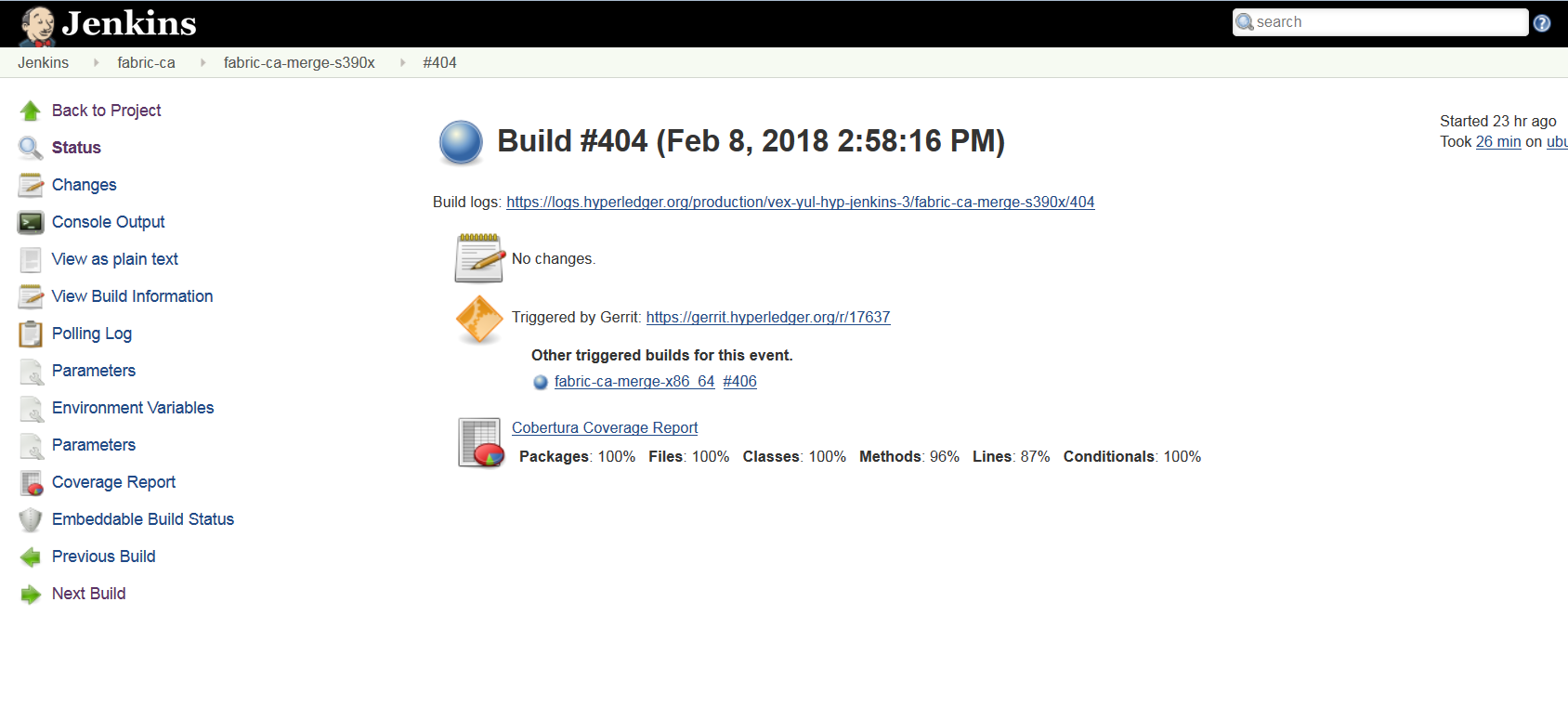Fabric-CA¶
This document explains the Fabric-ca CI process. The below steps explains what CI follows or executes when a patchset is submited to the fabric-ca repository.
Whenever a patchset is submitted to the fabric-ca repository, Jenkins triggers the CI build process to test and validate the patchset. Fabric-ca CI verify and merge jobs are configured to test the patchset in the below environment.
The Hyperledger Fabric (and associated) projects utilize various tools and workflows for continuous project development. The FABRIC-CA is currently utilizing the following versions in the Master , Release-1.0 and Release-1.1 branches.
Master:
- GO version(e.g. v1.9.2): https://github.com/hyperledger/fabric-ca/blob/master/ci.properties
- DOCKER version: 17.12.0-ce
- baseimage version(e.g. 0.4.6): https://github.com/hyperledger/fabric-ca/blob/be7180447ce9b47a4d3ae33210b5cf00d67ff6d9/Makefile#L55
Release1.0:
- GO version(e.g. 1.7.5): https://github.com/hyperledger/fabric-ca/blob/release-1.0/ci.properties
- DOCKER version: 17.12.0-ce
- baseimage version(e.g. 0.3.1): https://github.com/hyperledger/fabric-ca/blob/d5aa9afd6044201acd225494ee8c7537cd5a6673/Makefile#L47
Release1.1:
- GO version(e.g. 1.9.2): https://github.com/hyperledger/fabric-ca/blob/release-1.1/ci.properties
- DOCKER version: 17.12.0-ce
- baseimage version(e.g. 0.4.6): https://github.com/hyperledger/fabric-ca/blob/d536f5a4b9dbfe057af16dd5ae2ab87841b80f9c/Makefile#L62
If you would like to know more details on the tool versions, you can refer from any FABRIC-CA jobs listed here fabric-ca, select one of the jobs, click on any build number in the bottom left and view the output for details.
Build Process¶
There are several Jenkins job types that are common across Hyperledger Fabric projects. In some cases, you may or may not see all of the common job types in every project. This depends on the specific needs of that Hyperledger Fabric project. The CI configuration is prepared in Jenkins Job Builder to create, update and modify the Jenkins Jobs.
As part of the CI process, we create JJBs (Jenkins Job Builder) in YAML format to configure Jenkins jobs. JJB has a flexible template system, so creating multiple jobs with a common configuration which is easy. More details about Jenkins Job Builder are available in the JJB webpage.
The following steps explains, what happens when we submit a patch to the fabric-ca repository.
When a patchset is submitted to the fabric-ca repository, the Hyperledger Community CI server (Jenkins) triggers Verify jobs on x86_64 and s390x platforms using the patchset’s parent commit which may or may not be the latest commit on fabric-ca. The following verify jobs are triggered.

Views
Below are steps CI executes on Verify and Merge jobs:
fabric-ca-verify-end-2-end-x86_64
Step1: Clones the Fabric repository:
- Clones the latest commit from the Gerrit Fabric repository and then checkout to the Branch. If the patchset is triggered on Fabric release-1.0 branch, script will checkout to release-1.0 branch.
- After the Fabric and Fabric-ca repositories afre cloned in the above step, CI script executes to build DOCKER images to kick off the e2e tests.
Step 2: Executes the e2e tests:
Below are the tests triggers in Fabric-ca e2e job:
- e2e-cli - Runs fabric/examples/e2e_cli tests.
- Executes the network_setup.sh that spins up the network with docker-compose file from fabric/examples/e2e_cli folder.
- e2e-cli - Runs fabric/examples/e2e_cli tests.
- e2e-node - Runs the sdk-node e2e tests (Executes gulp test
command).
- Clones fabric-sdk-node repository and will checkout to Branch
- Spins up network using the docker-compose file from test/fixtures folder
- Install nodejs 8.9.4 version
- run
istanbul cover --report cobertura test/integration/e2e.js
- e2e-node - Runs the sdk-node e2e tests (Executes gulp test
command).
- e2e-java - Runs e2e java integration tests.
- If the patchset is on release-1.0 branch, we ignore java e2e tests for now.
- If not, run the java e2e tests by executing
source cirun.sh
- e2e-java - Runs e2e java integration tests.
fabric-ca-verify-x86_64 & fabric-ca-verify-s390x
Step1: Clones the Fabric repository:
- Clones the latest commit from the Gerrit fabric-ca and then checkout to the Branch. If the patchset is triggered on fabric-ca release-1.0 branch, script will checkout to the release-1.0 branch.
Step2: Executes fabric-ca tests using below two commands:
make ci-tests
make docker-fvt
Once the tests are completed, Jenkins posts +1 vote to the patchset +1 –> Hyperledger Jobbuilder upon successful completion and -1 -1 –> Hyperledger Jobbuilder in case of failure.
Once the patchset is approved by CI and the maintainers, they will merge the patchset which triggers below Merge jobs and runs the above mentioned tests on the latest fabric-ca commit (doesn’t use the patchset’s parent commit).
After the tests are executed, It is time to archive the logs (artifacts) and publish the code coverage. CI publishes the logs(artifacts) and the Code Coverage report(Cobertura Coverage Report)on Jenkins console.

ConsoleOutPut
Build Notifications¶
The build results can be viewed on the Jenkins console, where depending on the result it displays with a colored bubble (green for success, red for failure) and a vote from the CI (+1 or -1) on the Gerrit commit/change.
Also, it sends out an email notification to all the Fabric-ca maintainers in case of merge job failure.
Trigger failed jobs through Gerrit comments¶
Re-trigger of builds is possible in Jenkins by entering reverify in a comment to the Gerrit change that retriggers all the verify jobs. To do so, follow the below process:
Step 1: Open the Gerrit patchset for which you want to reverify the build
Step 2: Click on Reply, then type reverify and click Post
This kicks off all the Fabric-ca verify jobs. Once the build is triggered, verify the Jenkins console output and go through the log messages if you are interested to know how the build is making progress.
In some cases, Jenkins may fail only in one or two CI jobs due to which
network issues. In such cases, restarting all the fabric-ca jobs through
reverify comment is not necessary. Instead, the developer can post
below comment to trigger the particular failed build:
reverify-e2e- re-triggers fabric-ca-merge-end-2-end-x86_64 CI job.
reverify-x- re-triggers fabric-ca-verify-x86_64 on x86_64 platform.
reverify-z- re-triggers fabric-ca-verify-s390x on s390x platform.
Questions¶
Please reach out to us in https://chat.hyperledger.org/channel/ci-pipeline or https://chat.hyperledger.org/channel/fabric-ci RC channels for Questions or concerns related to fabric-ca CI process.